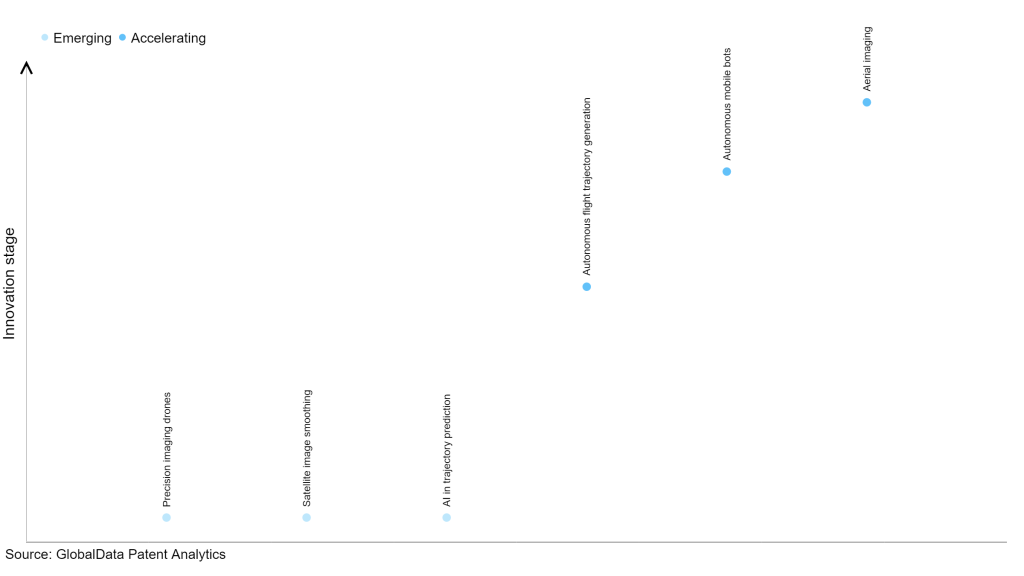The aerospace and defense industry continues to be a hotbed of patent innovation. Activity is driven by developments in artificial intelligence (AI) and machine learning, and the growing importance of technologies such as drones, satellite technology, and big data. In the last three years alone, there have been over 84,000 patents filed and granted in the aerospace and defense industry, according to GlobalData’s report on Artificial intelligence in defense: adaptive sensor fusion. Buy the report here.
However, not all innovations are equal and nor do they follow a constant upward trend. Instead, their evolution takes the form of an S-shaped curve that reflects their typical lifecycle from early emergence to accelerating adoption, before finally stabilizing and reaching maturity.
Identifying where a particular innovation is on this journey, especially those that are in the emerging and accelerating stages, is essential for understanding their current level of adoption and the likely future trajectory and impact they will have.
110 innovations will shape the aerospace and defense industry
According to GlobalData’s Technology Foresights, which plots the S-curve for the aerospace and defense industry using innovation intensity models built on over 260,000 patents, there are 110 innovation areas that will shape the future of the industry.
Within the emerging innovation stage, precision imaging drones, satellite image smoothing and AI in trajectory prediction are disruptive technologies that are in the early stages of application and should be tracked closely. Autonomous flight trajectory generation, autonomous mobile bots and aerial imaging are some of the accelerating innovation areas, where adoption has been steadily.
Innovation S-curve for artificial intelligence in the aerospace and defense industry

Adaptive sensor fusion is a key innovation area in artificial intelligence
Adaptive sensor fusion refers to the process of combining data from multiple sensors, such as radar, light detection and ranging (LiDAR), and vision systems, using machine learning algorithms to gain a more comprehensive understanding of a given environment. By adapting to changing scenarios and learning from experience, the system can better identify and track objects in real-time.
GlobalData’s analysis also uncovers the companies at the forefront of each innovation area and assesses the potential reach and impact of their patenting activity across different applications and geographies. According to GlobalData, there are 45+ companies, spanning technology vendors, established aerospace and defense companies, and up-and-coming start-ups engaged in the development and application of adaptive sensor fusion.
Key players in adaptive sensor fusion – a disruptive innovation in the aerospace and defense industry
‘Application diversity’ measures the number of applications identified for each patent. It broadly splits companies into either ‘niche’ or ‘diversified’ innovators.
‘Geographic reach’ refers to the number of countries each patent is registered in. It reflects the breadth of geographic application intended, ranging from ‘global’ to ‘local’.
Patent volumes related to adaptive sensor fusion
Source: GlobalData Patent Analytics
Mobility technology company Aptiv is one of the leading patent filers in adaptive sensor fusion. The company’s sensor fusion technology aims to bring together inputs from multiple cameras, LiDAR sensors, and radars to yield the most accurate and reliable representation of the vehicle environment by utilizing the best attributes of each sensor modality.
Aptiv was recently granted a patent for a method of imaging and radar fusion for multiple object tracking. The method involves detecting and tracking objects in multiple frames with the use of imaging sensors and radars and fusing the data gathered by each imaging sensor and radar to track multiple objects more accurately and reliably than using the sensor data separately to track objects.
Some other key patent filers in this space include NVDIA, Amazon.com, and Ford Motor.
In terms of application diversity, Aptiv, NVDIA, and Amazon.com are some of the leading innovators. By means of geographic reach, some of the leading patent filers include Epiroc, Stradvision and Amazon.com.
To further understand the key themes and technologies disrupting the aerospace and defense industry, access GlobalData’s latest thematic research report on Artificial Intelligence (AI) in Defense.
Data Insights
From

The gold standard of business intelligence.
Blending expert knowledge with cutting-edge technology, GlobalData’s unrivalled proprietary data will enable you to decode what’s happening in your market. You can make better informed decisions and gain a future-proof advantage over your competitors.



